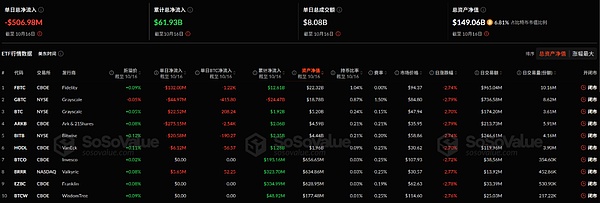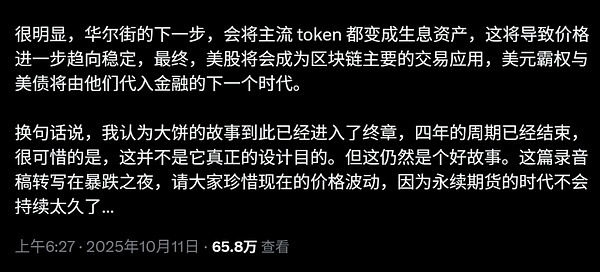If we divide the eras into "1.0/2.0/3.0," the tokenization of RWAs (real-world assets) has already gone through two stages. The 1.0 era saw the on-chain integration of non-standard assets, such as tokenized real estate and gold; the 2.0 era saw the on-chain integration of interest rate products, such as the yield-generating stablecoins and tokenized U.S. Treasury bonds (T-Bills) that emerged in the previous cycle. The 3.0 era, on the other hand, will see the tokenization of structured financial products, and even more diverse integrations of TradFi and cryptocurrencies. The most disruptive example of this is the practice of stock tokenization and ETF tokenization. This means that the most core and complex structured assets in the traditional capital market are entering the on-chain world. Crypto + TradFi = RWA 3.0 The process of Crypto landing in traditional finance (TradFi) is the prerequisite for the occurrence of RWA 3.0. Therefore, this transformation should actually be traced back to 2024 when the U.S. Securities and Exchange Commission (SEC) officially approved the listing of a Bitcoin spot ETF. It then quickly spread to the approval of the Ethereum (ETH) ETF, and to more crypto assets such as Solana and even Doge. Crypto's status as a "tradable target" has been finally confirmed in the traditional financial system. The biggest variable brought about by this premise is undoubtedly the influx of institutional liquidity. It completely resolves the concerns of large institutional investors and traditional funds regarding compliance and custody, effectively introducing trillions of dollars in funds and transforming cryptocurrencies from "non-mainstream assets" to "tradable targets." Of course, for investors who have only previously had exposure to traditional markets, this also means that the investment threshold is greatly lowered. They can buy and sell cryptocurrencies through familiar securities accounts, just like buying and selling stocks, greatly lowering the entry barrier.
According to SoSoValue data, as of the time of writing, the total net asset value of Bitcoin spot ETFs was nearly US$150 billion, the ETF net asset ratio (market value as a percentage of Bitcoin's total market value) reached 6.81%, and the historical cumulative net inflow reached US$61.9 billion. From this perspective,
the "ETFization" that began in 2024 has allowed Crypto to successfully complete the first step of "being accepted by TradFi."

Source: sosovalue
And RWA 3.0, it has to take the second step, that is, to make TradFi assets have "native encryption functions", the focus is on the RWA tokenization of US stocks that has been at the center of the narrative vortex this year:
Like Robinhood, they have successively announced support for US stock trading on the blockchain, and plan to launch their own public chain. At the same time, Kraken and others have also launched AAPL, TSLA, NVDA The emergence of US stock token trading pairs, such as ETFs, has sparked a wave of on-chain stock trading (further reading: "Behind the 'Stock Tokenization' Craze: The Evolution of the Tokenization Narrative"). From traditional financial giants like BlackRock exploring ETF tokenization to Web3 protocols like Ondo Finance launching tokenized stocks and ETFs, it signals that securities, the world's largest financial asset class, are deeply integrated with blockchain. The core significance of this convergence lies in not only putting cryptocurrencies on the fast track of traditional finance (ETF listings), but also endowing traditional stocks and ETFs with the superpowers of native crypto assets. Of course, in essence, moving RWA assets such as US stocks and gold to the chain only completes the "digital packaging" of assets and solves the problems of asset issuance and cross-regional circulation. However, if tokenized assets can only be circulated statically in wallets and cannot be used in combination, the composability advantage of the blockchain will be lost. Therefore, the real disruption is not what we can "buy" on the chain, but what new species and new gameplay we can "create". In short, the key to RWA's diversified landscape lies in application and liquidity (further reading: "Beyond Tokenization, the Endgame of RWA Financialization from On-Chain to Liquidity"). Objectively speaking, starting in 2024, from the financialization experiment of Crypto ETFs, to the structural innovation of "coin-stock combination", and then to the reverse extension of "stock-coin integration", the imagination space of RWA is being continuously broadened. However, Crypto ETFs and coin-stocks can only be packaging or hooking games in the capital market. Only starting with coin-stocks can it be regarded as a structural innovation that redefines the boundaries of assets.
The so-called "Crypto × Equity" is not a simple mix and match, but a possible path to reshape asset classes under the blockchain infrastructure, especially mapping the shares and rights of traditional securities to the value on the blockchain, releasing potential that traditional finance cannot match:
Mixed asset portfolio:The portfolio products include both stock tokens, ETF tokens, and mainstream crypto assets. For example, technology stocks + ETH are combined into a tokenized composite asset, providing users with a new risk diversification and return structure;
Equity derivative pledge:
This is one of the most disruptive application directions. Users can hold stock tokens and use them in DeFi Staking in the protocol can be used as collateral to obtain loans or participate in derivative transactions, achieving dual efficiency of assets;
cross-border liquidity coupling:For example, the stock token market can introduce DeFi liquidity mechanisms, connecting them with crypto assets through AMMs or order books, introducing traditional financial liquidity into DeFi, and breaking the trading hour restrictions of Wall Street (achieving 7×24 hour trading);
this integration will promote the deep interweaving of traditional financial asset pricing mechanisms and crypto financial liquidity mechanisms, bringing new funding curves and arbitrage opportunities.
it is even frankly said that
such a financial structure is almost impossible to exist in the traditional system, but on the blockchain, it is naturally possible to achieve it,not only improving capital efficiency but also making assets "live". Therefore, RWA actually represents an "incremental capital narrative." It not only provides DeFi with more stable, low-correlated, high-quality collateral, but also marks the first true handshake between the blockchain world and the real financial system. From a longer-term perspective, over the next decade, RWA may become a decisive turning point for Crypto's entry into the real economy and mainstream adoption (further reading: "As Crypto Moves Towards 'External Circulation,' Why Is RWA a 'Historic Bus' for Web3?"). The New Landscape After the Integration of RWA and Wall Street However, the outlook for the RWA landscape after the continued deep integration of Crypto and TradFi is not entirely optimistic.
It can be said that as Crypto assets gradually become "Wall Street-like" and "institutionalized," their underlying logic is also undergoing profound changes. As digital nomad Guo Yu guoyu.eth shared, in a market dominated by institutional capital and compliant products, Crypto native assets no longer represent the excess returns of the grassroots era, but a market with extremely high volatility but diminishing marginal returns. Liquidity dividends are beginning to give way to structural opportunities.

This means that under the new landscape of RWA 3.0, TradFi assets such as U.S. stocks will, on the contrary, squeeze the space for on-chain Altcoin and other Crypto native assets (further reading: "Pullback, Clearance and Recovery, the 4-Year Cycle Revelation of U.S. Stocks, A-Shares and Crypto").
The shift in asset selection logic: Investors have shifted from pursuing the liquidity premium of Alt to pursuing "verifiable, high-certainty" value;
Scarce certainty: Compared with Alt, U.S. stocks have higher certainty, information transparency and institutional maturity, and high-quality assets have smaller drawdowns and faster rebounds. Moreover, since corporate profits can be verified and policy cycles are predictable, the logic of the news can always be dug out;
From an investment perspective, this kind of certainty is precisely the most scarce value in the current liquidity environment. The significance of RWA 3.0 lies in introducing this scarce, deterministic value into the crypto ecosystem with maximum efficiency and composability. Conclusion The ultimate goal of RWA is to establish a unified, efficient, and barrier-free global financial infrastructure. By breaking the boundaries between "coins" and "stocks," tokenization creates the next stage of financial Lego and promises to accelerate this process. However, risks should not be ignored—challenges such as regulation, liquidity, custody, and off-chain asset proof remain. The ultimate outcome of RWA 3.0 remains a long-term game. The only thing that is certain is that when the certainty of finance meets the openness of Crypto, a decentralized, globally interconnected capital order is expected to be reconstructed on the chain.
 Miyuki
Miyuki






